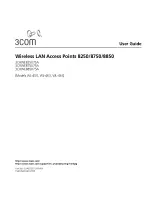
Unified Access Point Administrator’s Guide
Unified Access Point Administrator’s Guide
Page 126
January 2015
Appendix B - Configuration Examples
•) Use 1.3.6.1.4.1.171.10.128.1.1.26.10.3.1.16.1.4.97.99.108.49.2 to set apQosAclRuleCommit to a value of 1
(true), which saves the rule.
6.)
Use the apQosGlobalMode object to set the status to up (1), which enables Client QoS on the AP.
7.) Walk the apVapDescription object to view the instance ID for VAP 2 (wlan0vap2).
VAP 2 on Radio 1 is instance 5.
8.)
Use the apVapQosMode object to set the status of VAP 2 to up (1).
9.) Use the apVapAclUp object to apply acl1 to VAP2 in the inbound direction (from the client to the AP).
The ACL name is the text string, and not the ASCII code.
DiffServ Configuration
1.)
Load the DLINK-WLAN-ACCESS-POINT-X600-MIB module.
2.)
From the MIB tree, navigate to the objects in the apQos > apAclTable.
3.)
Use the apQosDsClassMapStatus object to set the status of the class map named class_voip to Create and Go
(4).
The OID to set is 1.3.6.1.4.1.171.10.128.1.1.26.10.4.1.3.10.
99.108.97.115.115.95.118.111.105.112
, where 10 is
the number of characters, and
99.108.97.115.115.95.118.111.105.112
is class_voip in ASCII code.
4.)
Configure class_voip to match all UDP packets from the 192.168.1.0 network that have a destination IP address
of 192.168.2.200 (the VoIP server).
•) Set apQosDsClassMapMatchEvery to true (1).
•) Set apQosDsClassMapMatchProtocol to UDP (17).
•) Set apQosDsClassMapMatchSrcIpAddress to 192.168.1.0.
•) Set apQosDsClassMapMatchSrcIpMask to 255.255.255.0.
•) Set apQosDsClassMapMatchDestIpAddress to 192.168.2.200.
•) Set apQosDsClassMapMatchDestIpMask to 255.255.255.255
•) Set apQosDsClassMapMatchCommit to true (1).
5.) Create a policy map named pol_voip (which is
112.111.108.95.118.111.105.112
in ASCII) by setting the value of
the OID 1.3.6.1.4.1.171.10.128.1.1.26.10.5.1.2.8.
112.111.108.95.118.111.105.112
to Create and Go (4).
6.)
Define the pol_voip policy map by adding the class_voip class map and specifying that packets that match the
class_voip criteria will be marked with a DSCP value of EF (expedited forwarding).
•)
Set
apQosDsPolicyMapAttrStatus.8.112.111.108.95.118.111.105.112.10.99.108.97.115.115.95.118.111.105.112.1
to a value of 4 (Create and Go)
•)
Set
apQosDsPolicyMapAttrMarkIpDscp.8.112.111.108.95.118.111.105.112.10.99.108.97.115.115.95.118.111.105.
112.1 to 46 (which is the equivalent of ef).
7.)
Enable Client QoS on the AP.
set client-qos mode up
8.)
Use the apQosGlobalMode object to set the status to up (1), which enables Client QoS on the AP.
9.) Walk the apVapDescription object to view the instance ID for VAP 2 (wlan0vap2).
VAP 2 on Radio 1 is instance 5.
10.)
Use the apVapQosMode object to set the status of VAP 2 to up (1).
11.) Use the apVapPolUp object to apply pol_voip to VAP2 in the inbound direction (from the client to the AP).
The policy name is the text string, and not the ASCII code.





































